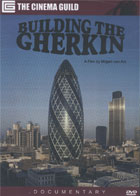
Building the Gherkin 2005
Distributed by Cinema Guild, 115 West 30th Street, Suite 800, New York, NY 10001; 212-685-6242
Produced by Kristian Widmer
Directed by Marjam von Arx
DVD, color, 52 min.
Sr. High - Adult
Architecture
Date Entered: 02/23/2007
Reviewed by Sandy River, Architecture and Humanities Librarian, Texas Tech UniversityNorman Foster and Partners won the 2004 RIBA Stirling Prize for their design of the London headquarters of Swiss Re, a reinsurance company. Because of its shape, the building is referred to as “the Gherkin,” a term that first was meant to express ridicule and disapproval but later became a term of endearment. This documentary chronicles the design and construction of the building from site selection to the opening party five months after the building was occupied. It has the feel of a highlight film or a video diary, and it shows, in a relatively short running time, the complicated path that major building projects take to completion. Footage was shot throughout the design and construction process, and the film features commentary by Foster, officers of Swiss Re, and their New Building Director, Sara Fox. Additionally there are clips from London television news reporting, remarks by London officials, and reaction from people in the street.
Successful architecture responds to the needs of the client, and this film gives us a glimpse of the negotiation between designer and client that continues throughout the building process. The Foster team learns much about how the company functions when they visit Swiss Re’s Geneva buildings. Creative ego is on display as Norman Foster describes the precedents for this building in earlier designs by the firm, and later when he comments that he might not have wanted to be involved in the project if he’d known that his firm would not get the contract for all of the interior work. Swiss Re keeps the design within bounds when Sarah Fox nixes the “too many gardens” that are in the plans.
While we see construction footage, the film offers more explanation of design features. The building is smaller at the bottom than in the middle to allow for the plaza that surrounds it. Six atria running up the sides of the building provide fresh air, and the glass façade accommodates the Swiss desire to be near windows. A triangular support structure makes the building unusually strong, a concern after the September 11 attacks. Interest in the story is sustained with the insertion of a countdown of time remaining to the occupation date. That adds a degree of suspense and tension which is also seen on the face of the project director, Fox. The relief and satisfaction demonstrated when the building is opened will be familiar to anyone who has ever had a house built.
The technical quality of the film is very good. Particularly striking are the views of the London skyline, the time lapse sequences showing the construction of the building, and the many views from various parts of London showing bits of the building above and between others. While the action takes place over four years and in many locations, the editing is quite smooth. The sound quality also is very good even though many segments are shot outdoors on the construction site.
This film would be very useful for beginning architecture students being introduced to the process by which a building goes from design to occupation. However, the skillful way in which the construction process is made a human story makes the film suitable for a much wider audience.
Awards
- Best Reportage, International Festival of Films on Art, Montreal, 2006